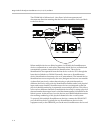
Design Guide for the Polycom SoundStructure C16, C12, C8, and SR12
2 - 28
The SoundStructure telephony cards have been designed to meet various
regional telephony requirements through the selection of a country code from
the user interface. For each telephony interface card, the signal processing is
listed in the following table and shown in the following figure.
The telephony transmit path includes dynamics processing, 10 bands of
parametric equalization, up to 1000 milliseconds of delay, a fader with gain
control from +20 to -100 dB, and a line echo canceller. There is also a tone
generator that is used to create DTMF digits and other call progress tones that
may be sent to the telephone line and also played into the local room.
On the telephony receive path, the processing includes up to 20 dB of noise
cancellation, automatic gain control, dynamics processing, 10-band
parametric equalization, fader, and audio delay. In addition there is a call
Telco Processing
Line echo cancellation, 80-3300Hz, 32msec tail-time
Dynamics processing: gate, expander, compressor, limiter, peak limiter on telco
transmit and receive
Up to 8th order highpass and lowpass filters
1st or 2nd order high shelf and low shelf filters
10-bands of parametric equalization on telco transmit and receive
Call progress detection
Signal fader gain: +20 to -100 dB
Automatic gain control: +15 to -15dB on telco receive
Signal delay on telco transmit and receive: up to 1000 msec
Noise cancellation: 0-20dB noise reduction on telco receive


















